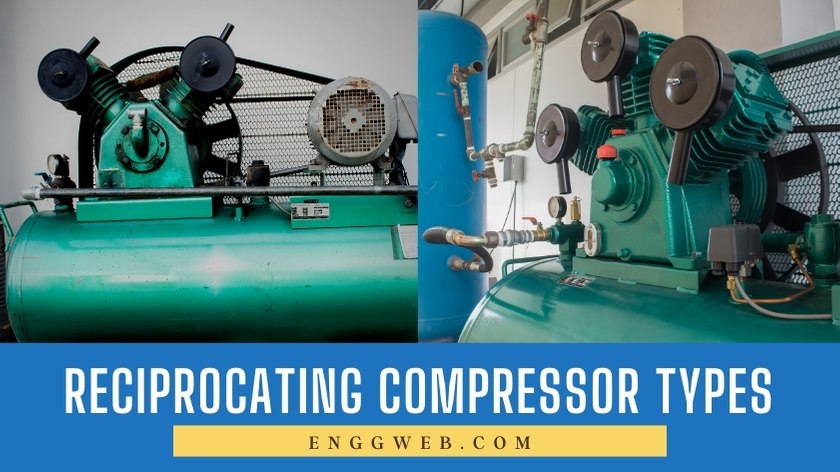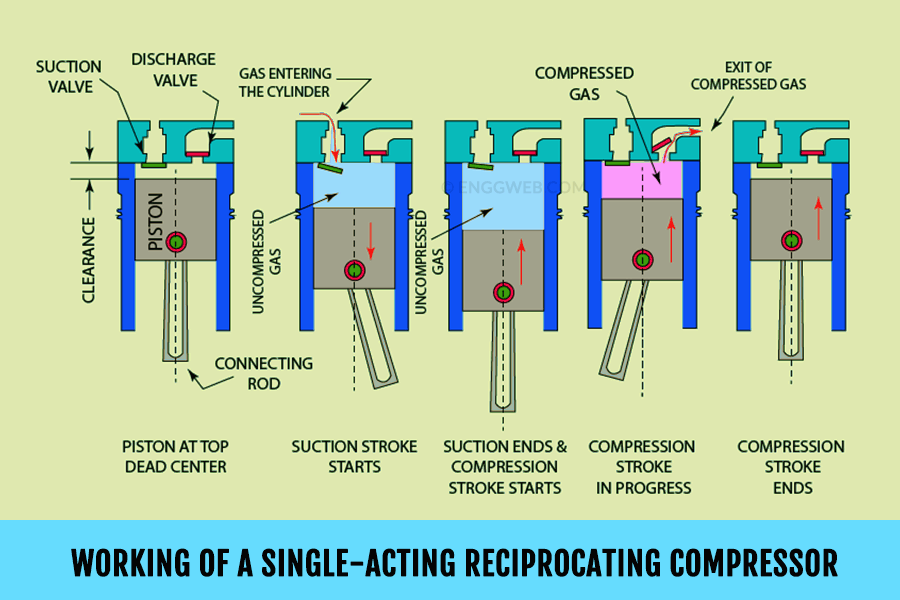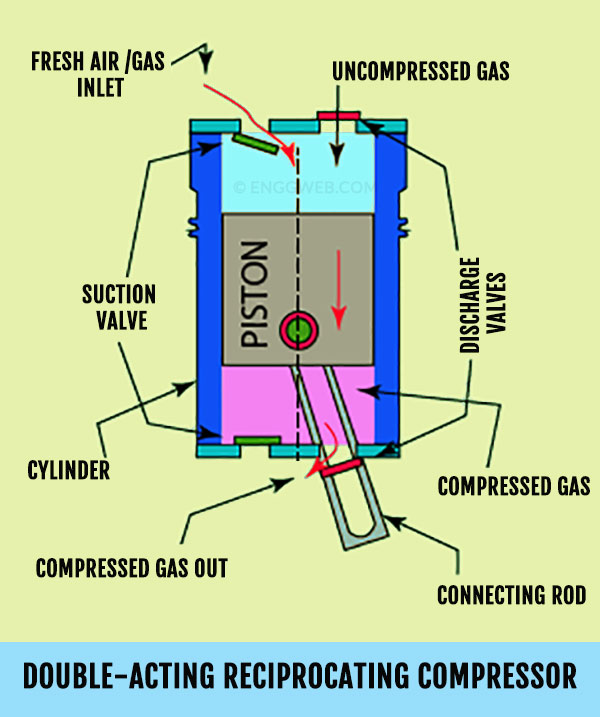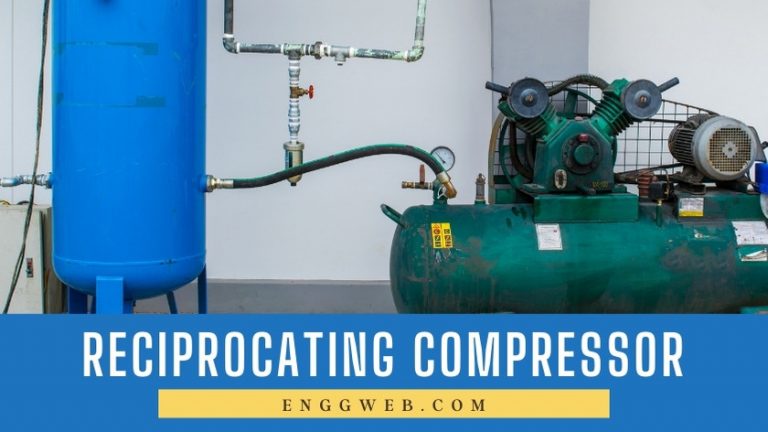Types of Reciprocating Compressors & Their Working Principles

The reciprocating compressor is a type of compressor in which the compression of the gas is achieved by piston strokes. The most common form of a reciprocating compressor is the piston compressor, which has a sliding piston located inside a cylinder containing the gas to be compressed.
The piston rod is attached to the piston and is itself pivoted about a horizontal axis.
The reciprocating compressor can be of single acting, double acting, or a diaphragm type; the reciprocating compressor can also be a single-stage (single or multi-cylinder) compressor or a multistage (multi-cylinder) compressor. Following are the different types of reciprocating compressors explained in detail.
Contents
Single-Acting Reciprocating Compressor
A single-acting reciprocating compressor has a set of valves at the top and there is one compression cycle for every revolution of the crankshaft.
Here the piston starts moving from the TDC (Top Dead Center) which is the topmost position the piston can reach to the BDC (Bottom Dead Center) and back in one crankshaft revolution.

When the piston moves from TDC (top) towards the BDC (bottom), the pressure in the cylinder falls below the atmospheric pressure, and due to the pressure difference across the suction valve, the suction valve overcomes the spring force and opens to allow the air into the cylinder.
As the piston moves from BDC towards TDC, the air is slowly pressurized, and the spring-loaded suction valve closes. When the piston approaches the TDC, the pressure of the air is sufficient to overcome the spring force of the discharge valve (outlet), and hence, the discharge valve opens to allow the air out of the cylinder at increased pressure. The cylinder becomes empty, the discharge valve closes, and the piston is ready to move towards BDC.
Double-Acting Reciprocating Compressor
The double-acting reciprocating compressor has two sets of valves, one each at the top and the bottom of the cylinder, and there are two compression cycles for every revolution of the crankshaft. When the piston is compressing the gas on one side, the gas is sucked into the cylinder on the other side of the piston.

When the piston moves from TDC towards the BDC, the pressure in the cylinder on the top side falls below the atmospheric pressure, and due to the pressure difference across the top suction valve, the suction valve overcomes the spring force and opens to allow the air into the cylinder.
While the suction is taking place on the top side of the piston, the air is getting compressed on the bottom side. When the piston nears the BDC, the pressure of the air on the bottom side of the piston is sufficient to overcome the spring force of the bottom discharge valve to open it and discharge the high-pressure air.
The piston now moves from BDC towards TDC and the lower discharge valve closes.
The air on the upper side of the piston is slowly pressurized, the upper suction valve closes, and when the piston approaches the TDC, the pressure of the air on the upper side of the piston is enough to overcome the spring force of the top discharge valve and hence, the discharge valve opens to allow the air out of the cylinder at increased pressure. The cylinder becomes empty, the discharge valve closes, and the piston moves towards BDC.
Meanwhile, the bottom suction valve is opened, and fresh gas has entered the bottom side of the compressor. This is ready to undergo compression when the piston moves from TDC towards BDC.
Double-acting reciprocating compressors are efficient than single-acting reciprocating compressors, however, the level of vibration is more, and needs a good foundation and vibration isolation.
Double-acting reciprocating compressors need a rugged design with slow speed and proper cooling for continuous operation. They are normally used in multistage style for high-pressure applications.
Diaphragm-Type Reciprocating Compressor
The diaphragm type compressor (also called membrane compressor) is a variant of the reciprocating compressor, and the compression of the gas happens due to the up and down movement of a flexible diaphragm or membrane.
The up and down movement of the diaphragm is achieved by connecting it with a piston driven by the connection rod and crankshaft.

The piston of your diaphragm-type compressor, instead of moving in a cylinder, pulls the diaphragm down (contraction of the diaphragm) to create suction and push the diaphragm up (expansion of the diaphragm) to create discharge.
Diaphragm type compressors are used for applications which need contamination and leakage-free process. Diaphragm-type compressors are popular for applications other than air.
The volume of the gas compressed, and the life of the diaphragm depends on the material of the diaphragm.
Diaphragm type of reciprocating compressor is used in many applications including compression of hydrogen and natural gas.
Diaphragm type of reciprocating compressors can be single or multi-stage.
Single-Stage Reciprocating Compressor
A single-stage reciprocating compressor has one or multiple cylinders connected parallelly. Here the air is compressed only once before it is moved to the final storage tank.
The discharge pressure achieved by a single-stage reciprocating compressor is limited by its design, and the maximum pressure may be 125 PSI (increasing the pressure beyond this may increase the temperature of the cylinder).
Advantages
They are simple in construction and are less expensive compared to multi-stage alternatives.
Disadvantages
Single-stage compressors have a lower pressure-ratio and low volumetric efficiency. The lack of inter-cooling will result in higher temperatures that can lower the life of the equipment.
Two-Stage Compressors
In the case of a two-stage or dual-stage reciprocating compressor, there will be two cycles of compression occurring in two cylinders that are connected in series. The gas is compressed in one cylinder (first stage), and the discharged gas is further compressed in the second cylinder (second stage), to a higher pressure.
The diameter of the second-stage cylinder is smaller than the first-stage cylinder. There will be an intercooler to cool the gas in between the stages.
Single-Stage vs Dual-Stage
Both single and dual-stage compressors can have multiple cylinders. The key difference between a single-stage compressor and a dual or multi-stage compressor is the number of times the air is compressed. That means, in a multi-stage device the air compressed from the first stage is sent to the next cylinder for further compression.
The other difference is the presence of inter-cooling between the two stages of compression. A multistage reciprocating compressor, with a good lubrication system, can achieve 250 PSI or more.
There can be more than two stages in a compressor.
Multi-Stage Compressors
Multistage (more than two-stage) reciprocating compressors have more than one cylinder and compress the gas in multiple stages.
However, all multi-cylinder reciprocating compressors may not be multistage compressors, since there are single-stage reciprocating compressors with more than one cylinder.
You can differentiate a multistage compressor from a multi-cylinder single-stage compressor by looking at the size of the cylinder. In a multi-cylinder, single-stage reciprocating compressor all the cylinders will be of the same size. However, in a multistage reciprocating compressor, the second stage cylinder will be of smaller diameter.
Receiver Tank
Do not get confused with the number of cylinders to the number of storage tanks. The cylinder with the moving piston inside is where the compression is happening and is relatively smaller in size. The receiver tank is where the compressed air is stored and is ready to deliver to your pneumatic tools.
Factories and large commercial establishments often have more than one storage tank since it is easy to balance the compressed air this way. It has nothing to do with the number of stages of compression.


